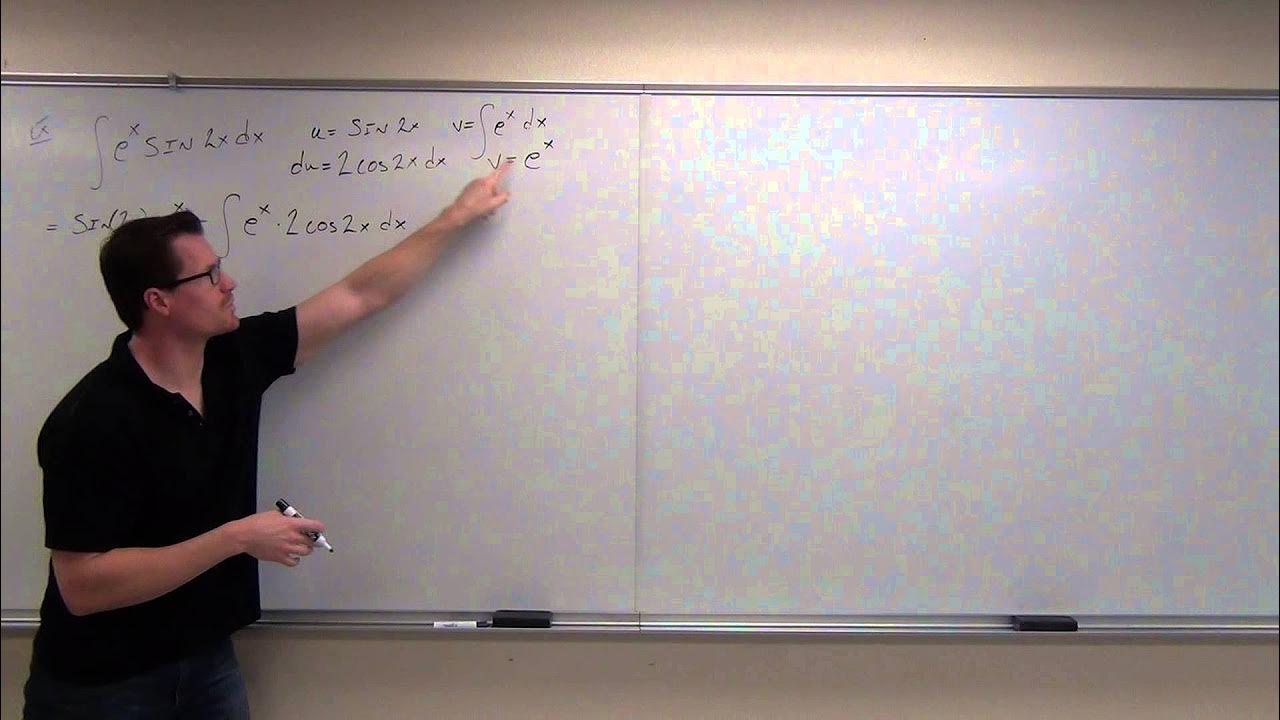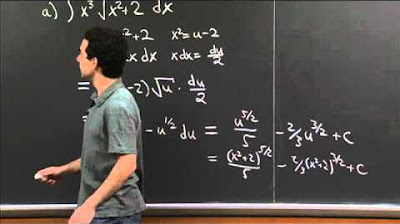Integrating sin^n(x) Using Reduction | MIT 18.01SC Single Variable Calculus, Fall 2010
TLDRThis educational video script guides viewers through deriving a reduction formula for the integral of sine to the power of n times x. The instructor emphasizes the goal of expressing the integral in terms of functions that involve lower powers of sine, ultimately aiming to eliminate the integral sign. The process involves strategic substitution using trigonometric identities and integration by parts, including a nested substitution for a manageable integration. The script concludes with a clear formula, highlighting the importance of algebraic manipulation in simplifying the expression.
Takeaways
- 📚 The goal of the video is to find a reduction formula for the integral of sine to the power n (sin^n(x) dx), denoted as Fₙ(x).
- 🔄 The objective is to express Fₙ(x) in a form that involves functions and integrals of sine to a lower power than n, thereby reducing the power of sine.
- 📐 The first step involves substituting sin^2(x) with 1 - cos^2(x) using the trigonometric identity sin^2(x) + cos^2(x) = 1.
- 🧩 This substitution helps break down the integral into two parts: one that involves sin^(n-2)(x) and another involving sin^(n-2)(x) cos^2(x).
- 📝 The term sin^(n-2)(x) corresponds to Fₙ₋₂(x), a lower power integral, which is a desirable outcome.
- 🔄 The second part, involving sin^(n-2)(x) cos^2(x), is more complex and requires integration by parts to solve.
- 🛠️ To simplify the integration by parts, a substitution is made: w = sin(x) with dw = cos(x) dx, turning the integral into a simpler form.
- ✏️ The integration by parts yields two terms: one is a product of functions, and the other is an integral of sin^n(x) again, which requires further manipulation.
- 🔄 By algebraic manipulation, specifically isolating terms, the final reduction formula for Fₙ(x) is achieved.
- 🧠 The process of reduction formulas can be applied similarly to integrals involving cosine functions, offering a method to tackle various integral reduction problems.
Q & A
What is the main objective of finding a reduction formula for the integral of sine to the power of n?
-The main objective is to express the integral in a form that involves functions, where any integral present is of sine to a lower power than n, allowing for the simplification of the integral and potentially eliminating the need for further integration.
What substitution is commonly used when dealing with powers of sine or cosine in integrals?
-The common substitution used is based on the identity sine squared x plus cosine squared x equals one, often replacing sine squared x with 1 - cosine squared x or using the half or double angle formulas when applicable.
What is the integral that the video aims to simplify, and how is it denoted in the script?
-The video aims to simplify the integral of sine to the power of n with respect to x, denoted as F sub n of x, which represents the integral of sine x raised to the power of n dx.
How does the script suggest breaking down the integral of sine to the power of n into more manageable parts?
-The script suggests using the identity sine squared x + cosine squared x = 1 to replace parts of the integral, resulting in terms that include sine to the power of n minus 2, which is easier to integrate.
What is the significance of the term F sub n minus 2 of x in the script?
-The term F sub n minus 2 of x is significant because it represents the integral of sine to the power of n minus 2, which is a reduced form of the original integral and is part of the reduction process.
Why is integration by parts a suitable method for the integral involving sine to the power of n minus 2 times cosine squared x?
-Integration by parts is suitable because it allows the transformation of the product of functions into a form that can be more easily integrated or differentiated, which is particularly useful when dealing with products of trigonometric functions.
What substitution is made during the integration by parts process in the script?
-The substitution made is letting w equal sine x, with dw being equal to cosine x dx, which simplifies the integral of powers of sine due to the derivative of sine being cosine.
How does the script handle the complexity of the integral involving sine and cosine squared?
-The script handles the complexity by first splitting the integral into parts, then using integration by parts and a substitution to simplify the integral into a form that can be more easily managed and integrated.
What algebraic manipulation is performed to isolate and solve for F sub n of x in the script?
-The script performs algebraic manipulation by adding 1 over n minus 1 times F sub n of x to both sides of the equation, simplifying the expression, and then multiplying both sides by n minus 1 over n to isolate F sub n of x.
What is the final form of the reduction formula derived for F sub n of x in the script?
-The final form of the reduction formula for F sub n of x is n over n minus 1 times F sub n minus 2 of x minus cosine x sine to the n minus 1 x over n, which represents the reduced integral without the need for further integration of sine to a power.
Outlines
📚 Introduction to Reduction Formulas for Sine Integrals
The video begins with an introduction to the concept of reduction formulas, specifically focusing on the integral of sine to the power of n with respect to x, denoted as F sub n of x. The goal is to express this integral in a form that involves functions and possibly other integrals, but only of sine to a lower power than n. The instructor encourages viewers to pause and attempt to solve the problem before continuing.
🔍 Exploring Reduction Strategies for Sine Functions
The instructor revisits the objective of expressing F sub n of x in terms of a lower subscript and discusses the strategy for reducing the power of sine x. A common substitution involving the identity sine squared x + cosine squared x equals one is introduced, leading to the manipulation of the integral into a form that resembles F sub n of x but with a reduced power. The process involves breaking down the integral and identifying terms that can be expressed as F sub n minus 2 of x, setting the stage for further reduction.
🧩 Integration by Parts and Substitution Techniques
The paragraph delves into the application of integration by parts to the remaining integral that does not fit the reduced form. The instructor outlines a strategy to split the integral and apply both integration by parts and a substitution technique. The substitution simplifies the integral to a form that can be easily solved, leading to an expression involving sine to the n minus 1 power, which is a step towards the reduction goal.
🎯 Final Reduction and Conclusion of the Sine Integral Problem
In the final paragraph, the instructor completes the reduction process by combining the results from previous steps and applying algebraic manipulations to isolate and solve for F sub n of x. The solution is presented in a form that includes a reduced power of sine and a function of sine, achieving the reduction goal. The instructor emphasizes the importance of recognizing the form needed for reduction and suggests practicing similar techniques with cosine functions as well.
Mindmap
Keywords
💡Reduction Formula
💡Integral
💡Sine Function
💡Cosine Squared
💡Substitution
💡Integration by Parts
💡Trigonometric Identity
💡Power Reduction
💡Algebraic Manipulation
💡Antiderivative
Highlights
Introduction to the task of finding a reduction formula for the integral of sine to the power of n.
Objective to express F sub n of x in a form involving functions with integrals of sine to a lower power.
The strategy to reduce the power of sine x in the integral using a reduction formula.
Common substitution technique using the identity sine squared x plus cosine squared x equals one.
Rewriting the integral to facilitate the reduction process by substituting parts of the sine function.
Breaking down the integral into two parts, one of which is similar to the original but with a lower power.
The use of integration by parts to tackle the more complex part of the integral.
Choosing appropriate functions for u and v prime to set up the integration by parts.
Performing a substitution to simplify the integral of sine to the power of n minus 2 times cosine x.
Calculating the integral of v prime and identifying the function v.
Completing the integration by parts and simplifying the expression.
Isolating the original function F sub n of x to derive the reduction formula.
Algebraic manipulation to solve for F sub n of x in terms of a lower power function and additional terms.
Final expression for F sub n of x incorporating the reduced integral and additional terms.
Explanation of the significance of the reduction process in evaluating integrals without the need for further integration.
Highlighting the importance of recognizing the form of the reduced integral for practical applications.
Suggestion to practice similar reduction techniques with cosine to the power of n for further understanding.
Conclusion summarizing the strategies and methods used in the reduction of powers of sine x.
Transcripts
Browse More Related Video

Integral of tan^4 (theta) | MIT 18.01SC Single Variable Calculus, Fall 2010

Calculus 2 Lecture 7.1: Integration By Parts

Integration Practice III | MIT 18.01SC Single Variable Calculus, Fall 2010

4.6 - Integration Techniques - Integration by Parts

Indefinite Integral

Integration Practice IV | MIT 18.01SC Single Variable Calculus, Fall 2010
5.0 / 5 (0 votes)
Thanks for rating: